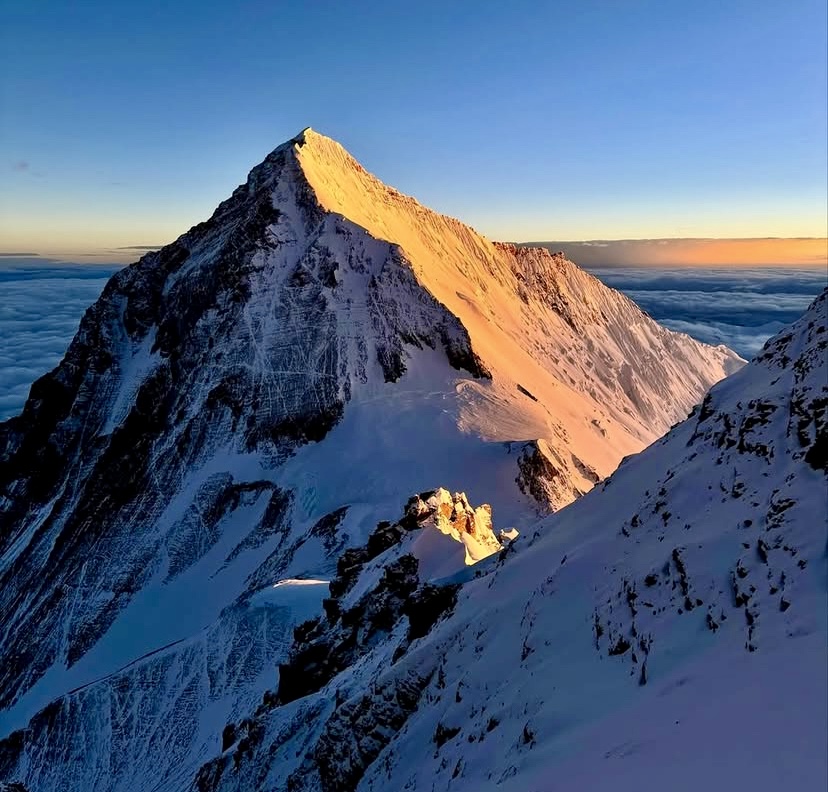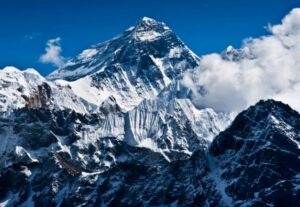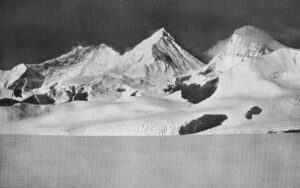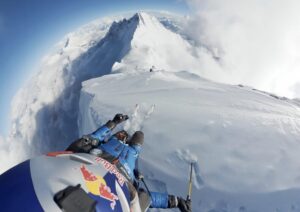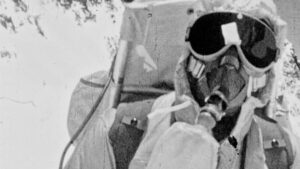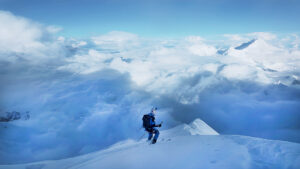This Everest season, Swiss-Ecuadorian Karl Egloff and American Tyler Andrews are both attempting record-breaking speed ascents.
Kaji Sherpa set the current Everest record (without bottled oxygen) back in 1998. Yet the late Elizabeth Hawley of The Himalayan Database noted a dispute about his ascent. It appeared in the Season Chronicles For The Nepalese Himalaya.
Everest 1998
In the spring of 1998, 32 teams aimed to climb Everest. Eventually, 118 climbers summited, including six without supplemental oxygen. Four climbers died: Americans Sergey and Francys Arsentiev, Roger Buick from New Zealand, and Mark Howard Jennings from the UK. The Arsentievs and Buick were climbing without bottled oxygen.
That autumn, nine expeditions arrived at the foot of the mountain. Five of the parties made attempts from the north.
An Italian group led by Sergio Martini aimed to climb the North Col-Northeast Ridge from Tibet without supplemental oxygen. Their attempt ended on September 25 at 8,100m because of deep, frequent snow deposits and strong winds.
Another party, the Japanese Fos Chomolungma Expedition led by Masafumi Todaka, climbed via the Japanese Couloir on the North Face. Later in the same season, they also attempted the Great Couloir route on the North Face without bottled oxygen. They reached 8,500m on the latter route, where they ran out of energy and retreated.

The North Col of Everest at 7,000m, with Changtse in the background. Photo: Jamie McGuinness
A Spanish team led by Maria Jesus Lago attempted the standard northern route without bottled oxygen. Their highest point was at 8,100m. Bad snow conditions and strong winds halted their summit push.
A U.S. party led by Craig Calonica also chose the standard northern route from Tibet without supplemental oxygen. They abandoned at 7,000m because of the dangerous snow conditions.
Finally, a French expedition led by Jerome Ruby took the same route, again without bottled oxygen, and aborted at 8,100m for the same reason as the others.
That season, none of the expeditions from the north succeeded, and all climbed without bottled oxygen.

The North Face of Everest from the Rongbuk Base Camp in the autumn of 1998. Photo: Jeff Shea
Teams from the south
Nepalese climber Kaji Sherpa led a five-member Speed Everest Expedition from the south via the normal route (South Col–Southeast Ridge). Kaji Sherpa climbed with Kami Sherpa, Kami Tshering Sherpa, Lhakpa Sherpa, and Tashi Tshering Sherpa. Kaji Sherpa was confident, aiming to ascend Everest in 18 hours.
A Spanish team led by Juan Corro also selected the normal route. This expedition included six Spaniards and three Sherpas.
The third expedition was a Japanese duo led by Ken Noguchi. It was also on the South Col-Southeast Ridge route. Four Sherpas supported the team.
The only team not on the normal route was another Japanese expedition, led by Norichika Matsumoto, to the Southwest Face. The team included eight Japanese and four Sherpas.
All the teams climbing from the Nepal side used bottled oxygen, with some complexities regarding Kaji Sherpa’s climb that we will detail later.

Camp 2 on the normal southern route. Photo: Madison Mountaineering
Summit bid
On October 14, Spaniards Corro and Carlos Pitarch and their two Sherpas, plus Noguchi from the Japanese party and his four Sherpas, were at Camp 4 on the South Col (7,900m).
On October 15, Corro and Mingma Sherpa decided to stay at Camp 4 because they were very tired and had some health issues. Eventually, they decided not to push for the summit and descended to a lower camp. Dorje, Pitarch, and the Japanese team started their summit push at 1:20 am on October 15.
At 8,300m, Dorje Sherpa decided to turn back. Pitarch made the “very risky decision” to continue. In strong winds and cloudy conditions, the Japanese group reached 8,350m at 4:00 am. There, they waited an hour for the weather to improve. Finally, Noguchi’s team turned around from 8,350m.
Pitarch’s account
Years later, in 2015, Pitarch detailed his thought process in an interview for a Spanish media outlet: “I remember Oct. 15, 1998, every day of my life. I was climbing with my companion Juan Corro and two Sherpas, but in the end, I was left alone with a Japanese man. He saw a cloud and became psychotic about the tragedy of 1996 and turned around. There was 300m left to the summit, and I did a self-analysis. ‘I feel good, and if I go down, I’ll never forgive myself.’”
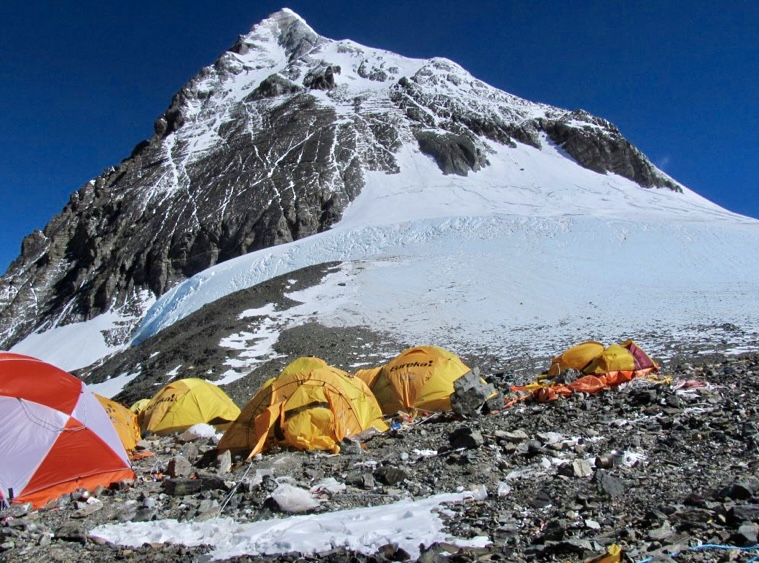
The South Col at 7,900m, with the summit pyramid behind. Photo: Wikipedia
According to Corro, the Spanish team leader, they were very angry that Pitarch continued when the team decided to abort. Corro believed that “ambition and the high altitude affecting his decisions” made Pitarch continue.
During his ascent, Pitarch’s oxygen system froze and stopped working at the bottom of the Hillary Step.
According to Pitarch, he reached the top on October 15 at 10:30 am. He was alone in extremely strong winds. Pitarch started to develop frostbite on his toes and fingers and felt very tired. One minute after summiting, he started to descend, reaching Camp 4 at 2:30 pm. Pitarch stated that his footsteps quickly disappeared because it had started snowing. By October 16, Pitarch was snowblind. He was unable to see the ropes, but Sherpas helped him reach Camp 2.
On October 16, the Nepalese Ministry of Tourism acknowledged Pitarch’s summit, making this the first ascent of the autumn season.

The Everest summit pyramid at sunset. Photo: Business Insider
Kaji Sherpa’s record claim
“This autumn was generally not a good time to be on the 8,000m giants in Nepal,” Elizabeth Hawley wrote for The Himalayan Database. “Climbers were plagued by heavy snow and fierce winds, but a Nepalese Sherpa claimed the fastest ascent ever made on Everest.”
The 35-year-old Kaji Sherpa said that he raced from Base Camp to the top of the world in a record-breaking 20 hours and 24 minutes without extra oxygen. He claimed to have cut two hours and five minutes from the previous no-O2 record, held by Marc Batard of France. Batard set that mark 10 years earlier via the same route (the normal route, starting at 5,300m).

The normal route on the upper section of Everest. Photo: Trekking in Nepal
Kaji Sherpa followed the same strategy that Batard had pioneered. He set off in the late afternoon and climbed all night, except for brief stops at established camps along the route. He made it to the summit early the following afternoon, October 17. However, according to Hawley, there were some differences between the two men’s tactics.
Different tactics
Batard climbed without teammates, although he did employ Sherpas to set up camps, and climbers from two other teams went ahead of him on his summit day and packed down a good track that Batard followed to the top.
On the other hand, Kaji had five team members, two of whom accompanied him on the last leg of his ascent from the South Col (7,900m). Batard and his Sherpas used no oxygen at any time, but two of Kaji Sherpa’s teammates, who climbed with him from the Col and broke trail for him, used bottled oxygen. Kaji also used oxygen during parts of his descent.
One of Kaji Sherpa’s men, Tashi Tshering Sherpa, summited a few minutes ahead of Kaji. The other team member turned back at 8,700m. During their descent from the South Summit (100m below the main summit), Tashi handed his oxygen set to Kaji, who used it until they were back at their camp on the South Col. The two men were in a hurry to reach their high camp as soon as possible.

Climbers start a summit push from the South Col of Everest. Photo: Coloradomountainlover
Doubts
Norichika Matsumoto’s party (the Japanese team attempting the Southwest Face) reached their highest point at 8,040m on October 11. They turned around because of a lack of time and supplies.
After aborting, Matsumoto spoke to Hawley. “I don’t think they [Pitarch and Kaji Sherpa] reached the summit. No pictures, no evidence. Pitarch couldn’t see properly after his oxygen supply stopped, he made an error,” he told her.
Matsumoto said that his sirdar watched the summit ridge through binoculars from Camp 2 for about an hour from 10:17 am. The sirdar saw no one despite good visibility. Matsumoto did not trust Kaji Sherpa’s account: “Kaji is a liar, he lied about not using Japanese radio and so many other things.”
Later, Kaji Sherpa produced a picture of himself holding a Nepalese flag, which he said showed him on the summit. But the photo didn’t show the old poles and prayer flags that summiters traditionally pose next to, and the snowfield he was standing in could have been anywhere.
Kaji said that the flags and poles were behind him in the photo. When it was pointed out that the picture was almost exactly the same as one of him on the summit in 1993, he explained that he always wears the same suit, belt, and cap. He insisted it was a new photo.

From left to right: Marc Batard, Tyler Andrews, and Kaji Sherpa in a recent photo. Photo: Marc Batard
Noguchi’s account
Noguchi (the Japanese climber who took part in the first part of the summit push with Pitarch and the others) told The Himalayan Database that after he turned back, Pitarch went on alone. Pitarch continued despite being very tired. There were also no fixed ropes, and the wind was very strong. According to Noguchi, Pitarch arrived back at the South Col at 4 pm with a summit claim. Noguchi said it was impossible to see above 8,500m because of clouds.
Kaji Sherpa doubts Pitarch
In turn, Kaji Sherpa questioned Pitarch’s summit. He said that he was on his summit push on October 17, only two days after Pitarch, and he saw that Pitarch’s footprints stopped above the South Summit.
Spanish leader Corro trusted Pitarch’s honesty and believed he summited. They had known each other since childhood.
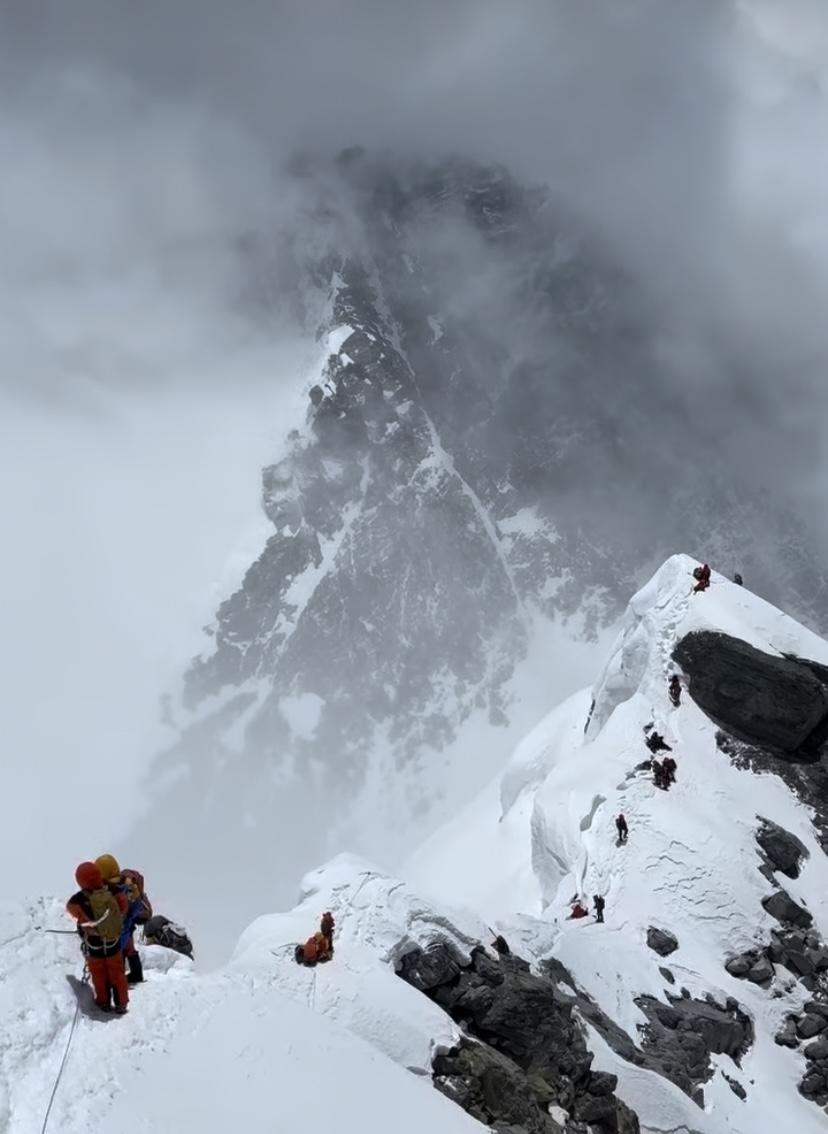
Looking toward the South Summit of Everest and Lhotse, on Everest’s summit ridge. Frame from a video by Dave Watson
Climbs officially accepted
Kaji Sherpa’s speed ascent was officially accepted as an oxygen-assisted ascent, as he used bottled oxygen on the descent. Tashi Tshering Sherpa and Pitarch’s summits were also accepted (with supplemental oxygen).

A birds-eye view of the summit of Everest. Camp 3 with tiny tents in the background at around 7,300m. Photo: Global Peaks
